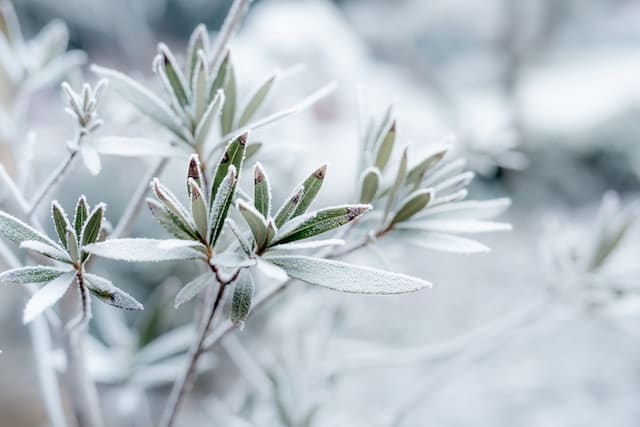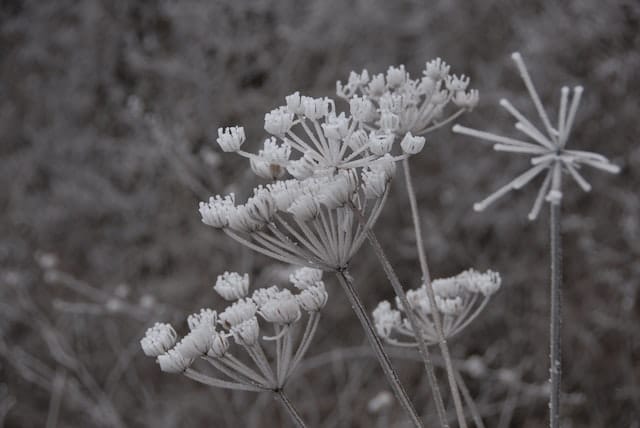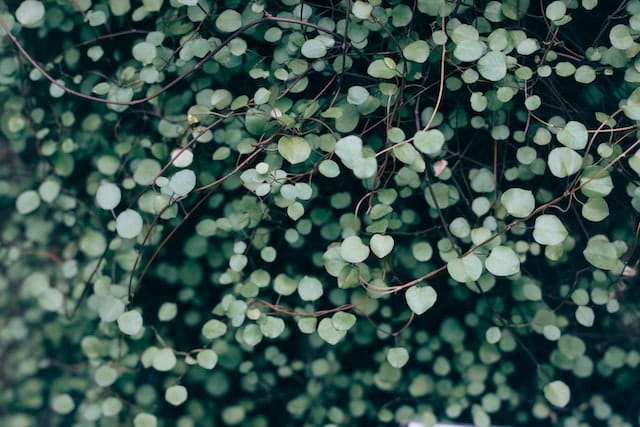
The average residential landscape uses minimal perennials, ornamental grasses, and groundcovers. This is unfortunate because while they are spectacular when in bloom, that show for woody trees and shrubs is usually limited to no more than a few weeks.
In addition to their extended and sometimes repeating bloom cycles, perennials have the unique qualities of elegant winter interest when complementing evergreens and woody landscape plantings. They share these characteristics with ornamental grasses and groundcovers, some of which happen to be evergreen.
Most important is that many perennial, ornamental grasses, and groundcovers have stems, seedheads, and foliage that partner with winter elements to create a subtle show, but also spectacular to those with a discerning eye for design.
Persistent Perennials
When perennials are left standing in your garden throughout the winter, you extend their utility. The foliage of these plants provides some much-needed insulation for the crown of the plant. Perennials also handle cold weather well because the sugars in the roots of these plants act as natural antifreeze. When looking for perennials to provide the best winter interest, find those with strong evergreen foliage or stems. Some also have very interesting seed heads that add texture to the garden.
Some perennials have groundcover qualities. Bergenia purpurascens is one example. It’s semi-evergreen foliage that transitions to colorful shades of red, maroon, and purple as the season progresses from fall to winter.

Black-Eyed Susans
Popular among pollinators, Black-Eyed Susans usually bloom from June to August, covering the open fields with their golden-yellow beauty. It is a member of the aster family and originates from North America. They attract butterflies, bees, and other insects using their nectar. They thrive in borders, landscape designs, butterfly gardens, and containers in the garden.
Although tough, these plants should not be overcrowded or watered on their leaves to avoid fungal infection. They come in different varieties that can be annual, biennial, or perennial.
Black-Eyed Susans are cold-hardy and survive the winter with the foliage dying back to the ground during the fall months, leaving the chocolate-brown seedheads on upright stems to punctuate the winter landscape. They typically stay dormant until spring. They are flowering plants
- Name: Rudbeckia hirta
- Growing Conditions: It does well in full sun but can withstand partial sun but will not bloom very well. It does best in fertile soil but can survive in harsh conditions
- Size: They can grow to 1-3 feet high, and their leaves can reach 6 inches
- Zone: It does well in zone 3-9
When creating winter interest in your Minnesota landscaping, don’t underestimate the beauty and power of herbaceous perennials, ornamental grasses, and groundcovers. Compared to trees and shrubs that are used as the background or backdrop of your landscape design, perennials, grasses, and groundcovers provide more intimate details that are best viewed up close.
The plants we have covered above can prove to be the foundation for any winter landscape. The dramatic interest, even when subtle, can be achieved easily as long as you know what will work the best.
Ornamental Grass
Ornamental grasses are versatile plants utilized in Minnesota landscape designs to offer four seasons of interest. They can be used to create a wow factor against any winter landscape. They include plants such as the following:
Feather Reed Grass
Feather reed grass is the most popular ornament grass. It provides a distinct upright habit capable of lasting the whole winter season and still looks fantastic. Just like other grasses, this plant can withstand callous conditions.
- Name: Calamagrostis ‘Karl Foester’
- Growing Conditions: Thrives in full sun and well-drained soil
- Size: Grows to 6 feet tall
- Zones: They are hardy in zones 5 to 9
Japanese Forest Grass
Japanese forest grass is a perennial ornament grass. It is among the rare grasses that do well in shady environments. It consists of arching, variegated leaves almost 10 inches long that descend in an orderly mounding clump 18 inches in height and 24 inches wide. Unlike other ornamental grasses, Japanese forest grass grows slowly and is not invasive.
It is usually planted as a container-grown nursery plant during spring, but you can also grow it when it becomes cool in the fall. It should not be planted in the dry summer heat. It takes almost a year to reach its full height then it spreads slowly in a manner that does not need to be controlled.
- Name: Hakonechloa macra
- Growing Conditions: It requires moist but well-drained, acidic, or neutral soil
- Size: It grows up to a height of 12-18 inches and 12-24 inches wide
- Zones: It is hardy in zones 4-9
Little Bluestem
Little Bluestem is an ornamental grass found in North America in all the contiguous states apart from those in the far Western coastal areas. Its upright habit, durability, and colorful foliage with hints of blue is making it increasingly popular. Little Bluestem is a native prairie grass with silvery-blue stems (at the base) and leaves, making your landscape design very attractive.
It is a warm-season grass that performs well in most areas of the country. Once it has matured, it becomes a drought-resistant, easy-to-care-for addition to residential landscapes.
- Name: Schizachyrium scoparium
- Growing Conditions: It grows best under full sun and is taller in fertile soil and shorter in infertile soil
- Size: They grow to around 1-2 feet
- Zone: It is hardy in zone 2 0r 3-10
Groundcovers

Groundcovers that grow low to the ground and are massed together to fill a designated space. Everyone is familiar with the most ubiquitous groundcover, better known as the turfgrass that is the great American lawn. Groundcovers protect the topsoil from erosion and drought.
The more common groundcovers in Minnesota landscapes are Pachysandra, English Ivy, and Euonymous or Purpleleaf Wintercreeper. All of these groundcovers are partial to fully evergreen, even during our tough winters. Purpleleaf Wintercreeper gets its name from the color it changes to during the autumn season.
Purpleleaf Wintercreeper
Wintercreeper is a woody flowering plant from Eastern Asia and parts of Europe. Wintercreeper is a perennial broadleaf, evergreen shrub capable of acting as a climber or groundcover. The main reason people grow it is the foliage and not its insignificant greenish-white flowers that emerge during spring.
It should be planted in the spring or early fall. Wintercreepers can climb up to 30-40 feet as a young plant with support. However, it stops creeping after maturity. It can spread out as ground cover if it has no support. Some people use wintercreeper for erosion control or as living fence material on their property.
- Name: Euonymus fortunei
- Growing Conditions: It needs full or partial exposure to sunlight. It can thrive in well-drained, acidic, neutral, or alkaline soil
- Size: It grows up to 70 feet as a vine and 2 to 4 feet as a shrub
- Zones: It is hardy in zone 5-9
English Ivy
English Ivy is an evergreen perennial plant. It can also be classified as a woody vine. It can function as a groundcover by spreading horizontally. It can also be used as a climber because its aerial rootlets enable it to climb up to 80 feet high.
The plant is grown for its evergreen leaves, although it can bear greenish flowers. Because of that, English Ivy can also be classified as a foliage plant. It should be planted in the spring.
English Ivy has vines that stay green throughout the winter, so it is perfect if you want a rich-looking ground cover for winter interest. It stays green and beautiful even as other plants become bare.
- Name: Hedera helix
- Growing condition: It requires part shade to full shade. It also thrives in fertile and moist, neutral to slightly alkaline soil
- Size: It can climb and spread as much as possible
- Zones: Hardy in zones 4 to 13
Architectural Landscape Design: Helping Homeowners Enjoy Better Living
Here at ALD, our top priority is creating living spaces that are right for you. Our landscape design team will work with you from concept to construction to create the right landscape for your personal needs. Contact us today for a free consultation to explore your next outdoor living project.
